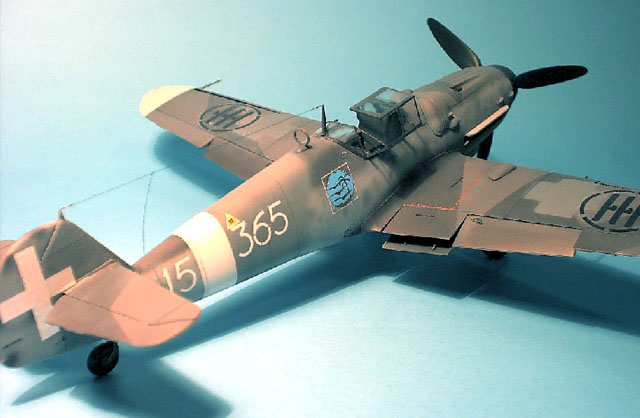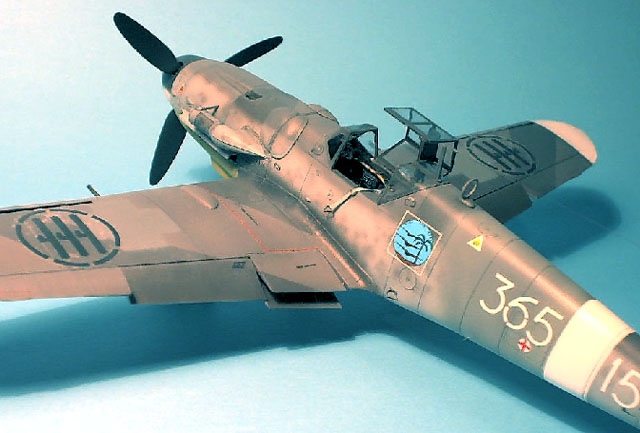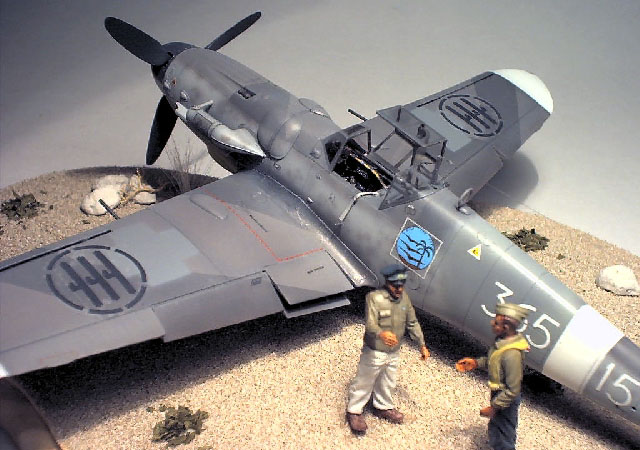|
Messerschmitt Bf 109G-6
by
Anthony Manzoli
 |
|
Messerschmitt Bf 109G-6
Regia Aeronautica-Flown by Ten. Giosue Carillo of 365` Sq., 150th Gr. Aut.
C.T., Sciacca, June 1943. |

Hasegawa's 1/48 scale Messerschmitt Bf 109G-6
is available online from Squadron.com
This is Hasegawa's excellent kit of the Me 109G-6 know also as the
"Gustav". I chose to build, paint and decal mine as the plane flown by
Lieutenant Giosue Carillo, of 365 Squadron, 150th Group, based at Sciacca
Italy in 1943.
I used the excellent reference materials from the Monogram publication
The Messerschmitt 109 in Italian Service by D'Amico and Valentini. The
book covers the 109's from the early models of the F to the late models of
the K. If you don't have this book, it is well worth every penny.
Hasegawa's 1/48 scale Messerschmitt Bf 109G-6 is delivered in a finely
engraved well fitting grey plastic. Very little filler was needed.
I decided from the start that I would be adding after market
accessories as well as scratch building some details to try to make the
kit a bit more interesting. I chose the Aires cockpit to upgrade the
interior. I really like Aires details, they have some nice cockpits and
the fit is pretty much dead on. I also like the fact that they supply a
fret of really nice photo etched parts which add that extra detailing. An
acetate dashboard is also provided as well as a superb Revi gun sight.

Once the cockpit was constructed, I painted it RLM 66 and picked out
the details. I also added the lap belts at this stage and painted them
light grey. The interior was dry-brushed with oils to bring out the
details. I went ahead and painted the insides of the fuselage RLM 66 as
well, just incase any of it would be noticeable.
As for the construction of the kit, it is quite straightforward. The
fit is exceptional and only minor filler is needed on the leading edges of
the wings, the under cowling. An important tip to remember is not to drill
out the holes for the upper wing cannon bulges. It is best if you leave
them shut, because they will show through the landing gear bays. I drilled
them as per the instructions to find out I had two holes in each landing
gear bay that needed filling. The additions I made to the standard kit
were, a bit of metal foil to line the center oil cooler, some small ribs
to add detail to the flaps, a few pieces of sheet plastic for the storage
area behind the cockpit and True Details weighted wheels. Once the basic
construction of the kit was completed, I moved on to masking the cockpit
off, and getting things ready for the painting process.
Using the references from D'Amico and Valentini's (discussed above), I
began painting the kit by pre-shading all of the panel lines with tire
black. Once the lines had dried I painted a majority of the plane with
Gunze RLM 76 Light Blue. This color must be sprayed lightly over the panel
lines until they are covered but still showing through.
The plane was left to dry over night and when dry to touch I began
painting the RLM 75 and 74 on the wings and fuselage. The wings were
painted with a hard edge splinter pattern and the fuselage the same with
mottling of the same colors. When these colors had dried, I mixed a shade
of grey for the Italian color light grey which was used to cover the
German markings and proceeded to spray the fuselage and wings. I used the
Luftwaffe crosses as templates and carefully sprayed them with a soft
edge.
The fuselage band and wing tips were masked and painted with Gunze flat
white and the under cowling was painted Gunze RLM 04 yellow. The paint job
was now nearly finished and it was allowed to dry.

I decided to dry brush the model, and apply some chips and oil streaks
at this time.
When all was done, I sprayed a few coats of Shine Magic to provide a
smooth glossy surface. when the Shine Magic was dry, I applied the decals
which were from the Sky decal sheet for Italian Bf 109's. The only
complaint with these decals was, that they were a bit thick, they did not
relax after multiple coats of Solvaset and Microsol. When the decals were
all on, I went ahead and sealed it once again using Shine Magic.
At this point the model was really starting to look good, I ended up
applying the finishing touches with the construction. I added a antenna
wire made from synthetic hair and insulators made from crystal clear glue.
I dry brushed the kit using oil paints and added paint chips with silver
pencil. The prop blades were painted RLM 70 black green and the spinner
was painted black and white with a soft edge.
I should point out that the actual plane would have been minus the
aerial loop antennae and the mast antennae would have been the longer
type. Another error I made was that the squadron emblem located on the
starboard side of the fuselage would not have been aligned with that of
the port side, it would have been staggered.

I chose to mount my kit on a base with some figures. I used the Verlinden Luftwaffe pilot and crew figures to make them appear as Italian
pilots. Since the Italians used the German flight coveralls, it was easy
to change the pilot to look like an Italian pilot. The other two figures
were painted to appear as to be wearing linen pants and flight jackets
with the 365 Squadron patch. I really like the Regia Aeronautica planes
and plan on doing a couple more of them with my other Gustav kit and my
K4.
Model, Images and Text Copyright © 2001 by Anthony
Manzoli
Page Created 18 October, 2001
Last Updated 04 June, 2007
Back to HyperScale
Main Page
Back to Features Index
|
Home
| What's New |
Features |
Gallery |
Reviews |
Reference |
Forum |
Search